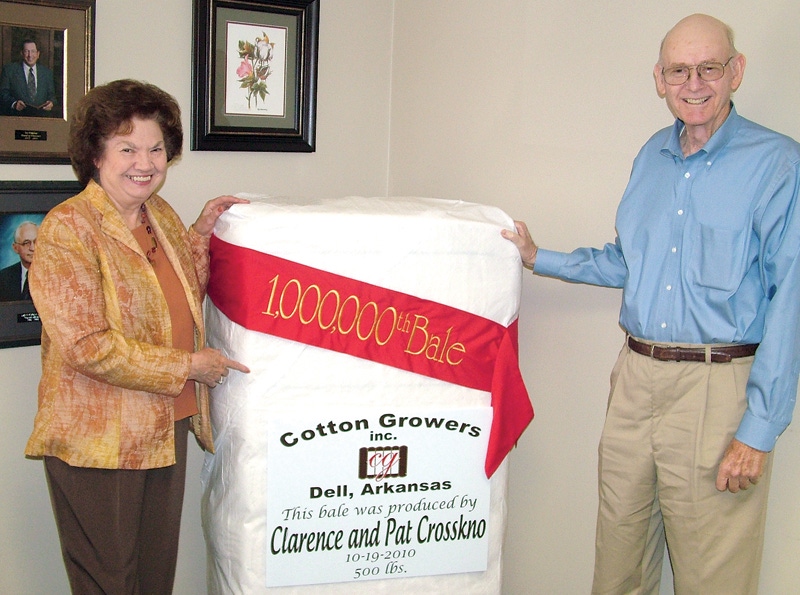
The first bale to come off the press at Cotton Growers, Inc., in Dell, Ark., symbolized the hope that a group of cotton producers could pool their resources and build something bigger than themselves.
Twenty years later, on Oct. 19, 2010, the millionth bale ginned by Cotton Growers was proof positive of what happens when hope meets a good plan, hard work and determination. It was a proud moment for board members and cotton producers Clarence Crosskno, Paul Fleeman, Allen Donner, L.H. Gaines, Louis Lammers, Bailey Weiner and Karen Dilldine.
It’s ironic that Crosskno, who is president of the board of directors for the gin, not only owned the 1 millionth bale, but also the first. Both bales were from Crosskno’s farm near in the Lone Oak, Ark., community.
The 1 millionth bale had premium quality, a 31-2-34, with 4.8 micronaire. The gin’s general manager Barry Braden says that the bale will likely be divided up into souvenir size bales. Tim Gipson, plant superintendent since the gin opened, ginned both the first bale and the 1 millionth.
The landmark 1-millionth bale also provided some optimism for an industry that has suffered production declines due to decreased cotton acreage in recent years. Fortunes could turn around soon. There is potential for a 30 percent increase in cotton acreage in northeast Arkansas next year.
The first organizational meetings for Cotton Growers, Inc., took place in Crosskno’s farm shop. “Twenty-one years ago, Clarence called me about building a gin,” said Weiner. “I can’t remember how much money we were trying to raise. But it finally took root. It’s good to see a man realize his dream. We couldn’t have done it without Clarence.”
“Our philosophy is to treat everybody the same whether he’s got 40 acres or 4,000,” said Crosskno, chairman of the board for Cotton Growers, in a 2004 article on the gin, http://deltafarmpress.com/gin-introducing-new-lint-cleaners.
“Our cotton all comes here voluntarily. That’s a big plus for the organization. Plus, we’ve got an excellent group of people to work with.”
Cotton producer and board member Paul Fleeman says the seven-member board at Cotton Growers, Inc., “has had a lot of heated discussions, but we always vote on everything. We’ve only had one time when the president had to break a tie. We’ve been successful in managing this company.”
Need for more ginning capacity
The original Cotton Growers, Inc., gin plant, in Dell, Ark., was installed in 1991 and grew out of a need for more ginning capacity in the area. The gin provides service for growers in Arkansas and Missouri.
The 1991 gin consisted of a module feeder, three Continental 161 gin stands, six 24-D Continental lint cleaners (to provide double lint cleaning if necessary) and a Continental 800 press. The average production of the gin was approximately 42 bales per hour.
In 2001, an additional line was installed, which consisted of one Continental 161 gin stand, two 24-D Continental lint cleaners and a BesPress press, bringing average production to approximately 55 bales per hour.
In 2004, a second gin was built at the location. In order to duplicate grades produced by the original plant, spare parts inventory, repair staff familiarity, etc., the new plant was designed to be as much of a duplicate of the original plant as possible. It consists of a module feeder, three Continental 161 gin stands and six 24-D lint cleaners. This plant uses a Continental 9500 press. Both gins together have the potential to process a little over 100 bales per hour.
Other equipment at the gin complex includes three Consolidated battery condensers, Samuel Jackson moisture control systems, LouverMax lint cleaning systems and Jen-Glo tie systems.The LouverMax lint cleaners allow up to seven grid bars in each cleaner to be bypassed if necessary. The technology, called prescription lint cleaning, can add as much as 12 pounds of lint to a bale of cotton.
Crosskno has farmed since 1950, and remains actively involved in his farming operation. He left the farm in the late 1950s for a two-year stint in the Army, and returned to farm and married in 1960. Today, Crosskno and his wife, Pat, farm around 4,000 acres, but both pride themselves on keeping the farm a family operation.
Original incorporators of Cotton Growers, Inc., included Crosskno, Paul Fleeman, Danny Bourland, Allen Donner, and Joe Dilldine.
Joe Dilldine served as board member until 1999 when he resigned due to health reasons. His son, Tommy Dilldine, filled the vacancy and served as board member until his death in 2010. Tommy’s widow, Karen Dilldine, filled the vacancy following his passing.
According to Braden, over the last 20 years, almost $12 million in rebates have been paid to producers, and nearly $2.5 million in dividends paid to its 62 stockholders.
About the Author(s)
You May Also Like






